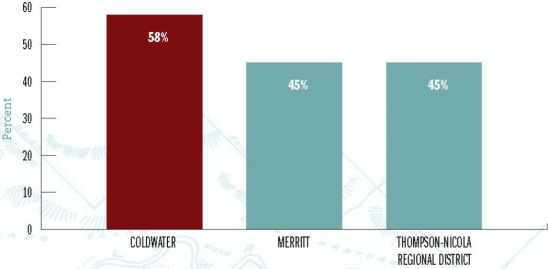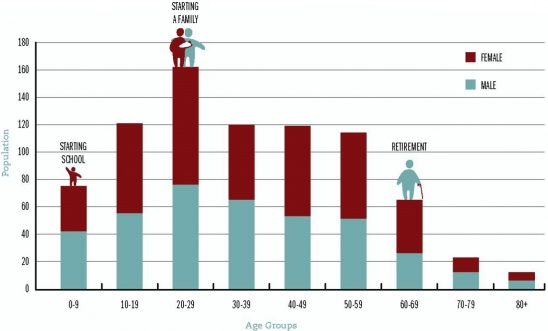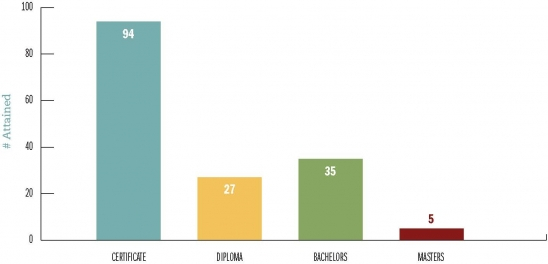Our community life is organized according to seven traditional principles that guide us in healthy, stable, strong and joyful living:
- Our Elders are our teachers
- Our Youth are our future
- Connection to our people, lands and resources identifies us
- Respect for our ancestors guides us
- Healthy membership and community empower us
- Stewardship of the land is our responsibility
- What we do today will provide prosperity for seven generations
Print
Email

Membership
According to June 2013 population information2, we have 818 members, 344 of whom live on one of the Band’s two occupied reserves, 55 of whom live on the reserves of other First Nations, and 419 of whom live off-reserve, primarily in towns and cities like Merritt, Kamloops, Kelowna and Vancouver.
We have a young population, with 478 (59%) of our members under 40 years old, compared to 45% in Merritt and the surrounding Thompson-Nicola Regional District. However, we are ageing, with over 12% of our population over the age of 60. This is up from 11% in 2010. This means 100 members are over 60 years old, up from 74 in 2010.
Percent Population Under 40 Years Old
Our membership is also growing. Our historical growth has been approximately 3%-5% per year. Since 2010, our population grew by about 3%. Assuming this rate continues, we project there will be 1,102 Coldwater members in 10 years, and 1,483 in 20 years. At a 5% growth rate, our population would number 1332 in 10 years, and 2,170 after 20 years.
This anticipated population growth has a number of implications for community life – including both opportunities and challenges. A strong, young population means a strong, young workforce ready to create and accept opportunities to build the local socio-economic fabric. However, a growing population will also put pressure on already stretched resources.
A closer look at our population broken down by age can help us consider the types of facilities and services that we may need in the coming years. The changing size of different age groups and families will impact the provision of community services and facilities, housing, education, and health.
Our membership is also growing. Our historical growth has been approximately 3%-5% per year. Since 2010, our population grew by about 3%. Assuming this rate continues, we project there will be 1,102 Coldwater members in 10 years, and 1,483 in 20 years. At a 5% growth rate, our population would number 1332 in 10 years, and 2,170 after 20 years.
This anticipated population growth has a number of implications for community life – including both opportunities and challenges. A strong, young population means a strong, young workforce ready to create and accept opportunities to build the local socio-economic fabric. However, a growing population will also put pressure on already stretched resources.
A closer look at our population broken down by age can help us consider the types of facilities and services that we may need in the coming years. The changing size of different age groups and families will impact the provision of community services and facilities, housing, education, and health.
Print
Email

We strive to provide quality educational opportunities for all our members – from the youngest children to older members interested in completing their education or seeking additional training in a chosen field.
The Coldwater Aboriginal Head Start Program currently encourages the growth and development of 41 of our community’s children aged 0-4. It includes a Parent & Tots program and a Nursery Program for the 4 year olds.

We run the Nc'?etk?u Band School on the Coldwater reserve serving 23 members from pre-Kindergarten to grade 7, an accredited elementary school. We also run the Resource Tech Adult Program out of the same facility with 34 students currently enrolled. The school was built in 1997 and includes state-of-the-art classrooms, outdoor learning spaces, an administration area, and a gymnasium that can accommodate up to 300 people.
Other young Coldwater members attend primary and secondary schools in nearby Merritt, which is part of School District 58.
Members also take part in degree and diploma programs at local colleges and universities such as the Nicola Valley Institute of Technology (NVIT) in Merritt, Thompson Rivers University in Kamloops, and through various Open Learning programs. There are currently 16 Coldwater members attending college or university, and over the years Coldwater members have attained numerous certificates, diplomas, Bachelors degrees and Masters degrees.
The Band’s Education Department is committed to our students’ success and provides support in the form of sponsorship for Post Secondary utilizing available federal education funding as well as a bursary for the Bachelor of Social Work program at the Nicola Valley Institute of Technology NVIT.
Another aspect of education is traditional culture and language. Currently we offer cultural programs at the Band Hall where members can learn traditional skills like making dipnets, drums, baskets, and moccasins. We are in the process of restoring a sheestkin (pithouse) located next to the Nc’tetkwu Band School so that it can be used for cultural education programs.
Print
Email

We have a young and growing workforce with increasing levels of educational attainment.
Of our 818 members, 553 (68%) are of an employable age, though many rely on income assistance to meet their basic needs. The majority of Coldwater workers are employed in government and forestry sector jobs, though members have expressed great interest in diversifying career options.
We currently offer employment services such as support for computer training in our Access Centre, small machines operator training, and small business support services. Additional training and economic development are still required to raise employment levels among our membership.
A 2009 survey of Coldwater members revealed that the full-time to part-time worker ratio for our members was approximately 60:40, a figure that was relatively constant for our on-reserve and off-reserve members. However, figures on the length of employment for Coldwater members revealed that only 27% of members living on reserve had been employed continuously over the past year compared to 43% for those living off-reserve. Although these employment rates are considerably lower than employment rates in neighbouring metropolitan areas, they are also indicative to some extent of the seasonal nature of natural resource sector work in the region.
Print
Email











